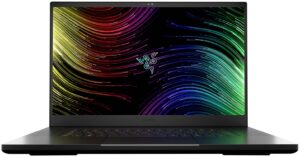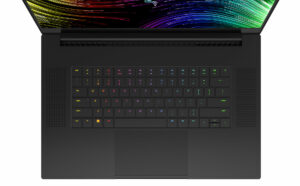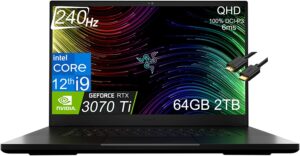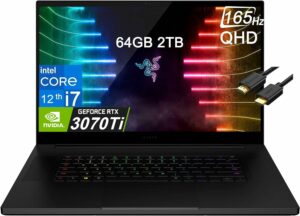[Video Review] Razer Blade 17 (12th Gen Intel) – Potent mix between gaming and content creation
Razer Blade 17 (Early 2022) in-depth review
The Blade 17 is Razer's most powerful offering as of the time of writing this review. Nothing unexpected, though, considering the fact that it is the largest device from the family.Things scale pretty well in the Razer portfolio, as each size comes with a progressively higher GPU TGP limit. In the case of Blade 17 (Early 2022), we are talking about the RTX 3060, RTX 3070 Ti, and RTX 3080 Ti. While the first is pretty competitive in both pricing and power limits, the other two are absolute beasts.With a TGP of 150W and 165W, respectively, these two sit at the sharp end of the gaming gr[...]
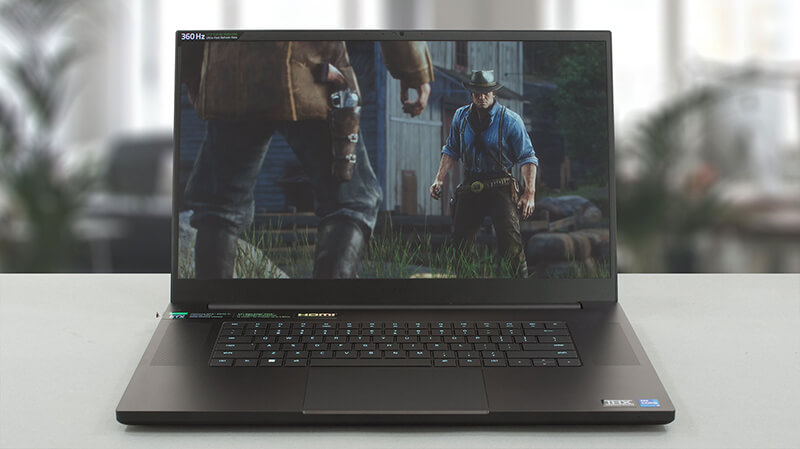
Pros
- 2x M.2 PCIe Gen 4 slots, 2x RAM SODIMM slots in dual-channel
- Covers 99% of the sRGB color gamut and has accurate color representation with our Gaming and Web design profile (360Hz 1080p panel)
- No PWM (360Hz 1080p panel)
- Snappy panels with quick response times
- Vapor chamber cooling system
- 2x Thunderbolt 4 + IR face recognition + SD card reader
- Wi-Fi 6E + 2.5 Gbit LAN port
- Has a MUX switch
Cons
- Its keyboard is not ideal for gaming
- HDD/SSD
- up to 2000GB SSD
- M.2 Slot
- 2x 2280 PCIe NVMe 4.0 x4 See photo
- RAM
- up to 64GB
- OS
- Windows 11 Home, Windows 11 Pro
- Battery
- 82Wh
- Body material
- Aluminum
- Dimensions
- 395 x 260 x 19.9 mm (15.55" x 10.24" x 0.78")
- Weight
- 2.50 kg (5.5 lbs)
- Ports and connectivity
- 3x USB Type-A
- 3.2 Gen 2 (10 Gbps)
- 2x USB Type-C
- Thunderbolt 4, Power Delivery (PD)
- HDMI
- 2.1
- Card reader
- SD
- Ethernet LAN
- 10, 100, 1000, 2500 Mbit/s
- Wi-Fi
- 802.11ax
- Bluetooth
- 5.2
- Audio jack
- 3.5mm Combo Jack
- Features
- Fingerprint reader
- Web camera
- FHD + IR scanner
- Backlit keyboard
- Microphone
- 4x Microphone Array
- Speakers
- 8x Stereo Speakers, THX Spartial Audio
- Optical drive
- Security Lock slot
- Kensington Lock
All Razer Blade 17 (Early 2022) configurations
[Intro]
The biggest of the Razer Blades, at least for now, comes with pretty powerful hardware from Intel’s 12th Gen Alder Lake H-series and the RTX 30-series graphics. It combines sleekness and performance in a 17.3-inch chassis that weighs as much as some 15.6-inch laptops, which is an achievement on its own.
[Design]
It’s 2.50 kg to be specific and made entirely out of aluminum. It’s quite thin, at 19.9 mm, which pairs very well with the flat lid and bottom panel. Durability is very good, as the lid opens easily with one hand while remaining rigid when we try to flex it.
[Input devices]
On the base, we see large speaker grills, flanking the keyboard. Despite the 17.3-inch form factor, you don’t get a NumPad. Razer also still hasn’t totally figured out how to make a keyboard for a gaming laptop, as the key travel is too short for our liking. On the bright side, the feedback is clicky and you get a per-key RGB backlight, so typing is still relatively comfortable.
The touchpad is still one of the best that we’ve tested, as the glass surface is incredibly smooth, while the surface is large and incredibly responsive.
[Ports]
Going to the sides, the left one keeps a charging plug, a LAN port, two USB Type-A 3.2 (Gen. 2) ports, a Thunderbolt 4 port, and a 3.5 mm audio jack. On the other side, there’s an HDMI 2.1 port, one more USB Type-A port, another Thunderbolt 4 port, and an SD card slot.
[Display]
On the front, you have several displays to choose from, with Full HD, Quad HD, and 4K displays available. We tested a Full HD IPS panel, which is amazing for esports titles and shooters, where the 360Hz refresh rate comes in handy, especially when you also factor in the 9 ms response time. If you’re looking to expand in the field of Creator work, the FHD panel has you covered, with 99% sRGB coverage. We also recommend using our Design and Gaming profile, which calibrates the display and gives us a dE value of 0.9, which is excellent for any type of color grading that you’ll need to do.
We’ll leave links to our display profiles in the description below.
[Sound]
The sound that comes off of the stereo speakers is excellent as well, for a laptop at least, with loud max volume and no significant deviations across the entire frequency range.
[Performance]
Finally, let’s have a look at the performance. The Blade 17 is offered with both the Core i7-12800H and the Core i9-12900H, both of which have the same cache size, cores, and threads. We tested the Core i7, which performs just as well as the same CPU inside the smaller Blade 15, in both 3D and 2D Rendering.
In terms of graphics, the RTX 3070 Ti that we have here comes with a higher 150W power limit, when compared to the 110W unit inside the Blade 15. Ultimately, this means more performance in both benchmarks and games.
Here’s the RTX 3070 Ti crushing God of War at 1080p Ultra settings, running at 103 fps. We’ll also leave links to our LaptopMedia Benchmarks channel, which has even more games tested on the 3070 Ti, as well as tests on all the latest and most popular graphics cards.
[Cooling]
Cooling the CPU and GPU is left to a huge vapor chamber with two fans. There’s also a third fan that splits the 82Wh battery in half and offers extra airflow. The stress test shows the Core i7 push to high TDPs and clock speeds at the beginning of the test while settling at 53W in long runs. Still, while it looks low, it won’t be a bottleneck for the GPU, which takes full advantage of its 150W power limit, while reaching just 75°C. These temperatures can’t be felt on the outside, as the base gets a hotspot of 39.7°C. As you can see, the third fan helps with moving extra air around the chassis.
[Battery]
Now, let’s look at the efficiency of the Blade 17. The 82Wh unit doesn’t offer the longest battery life, with only 7 hours and 43 minutes of web browsing, and 5 hours and 52 minutes on a single charge, which is all the efficiency toggles turned on.
[Teardown and upgradeability]
However, the laptop gets the upgradeability right, offering two SODIMM slots for DDR5 memory, as well as two M.2 PCIe x4 slots for Gen 4 SSDs.
We’ll leave our teardown video, which shows how to upgrade the Blade 17.
[Verdict]
The Razer Blade 17 isn’t perfect, however, it manages to bring very good performance inside a relatively portable and stylish 17.3-inch chassis. The keyboard and battery life still need to be improved, but overall we know for sure that the laptop will find its following if it hasn’t already.
For more information about the Razer Blade 17, check out the written review on our website. It’s in the description below.
